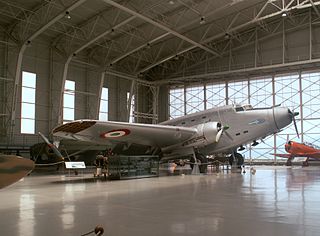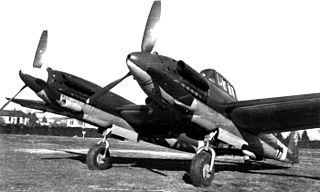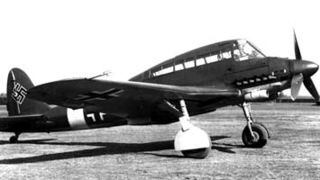Related Research Articles

The Savoia-Marchetti SM.81 Pipistrello was the first three-engine bomber/transport aircraft serving in the Italian Regia Aeronautica. When it appeared in 1935, it represented a real step ahead in Italian military aviation: it was fast, well armed and had a long range. It proved effective during the war with Ethiopia and the Spanish Civil War. Despite being too slow to remain competitive as a bomber in the later years of World War II, it was one of the most flexible, reliable and important aircraft of the Regia Aeronautica from 1935 to 1944, and adapted to second-line duties in a wide range of tasks.

The Breda Ba.88 Lince ("Lynx") was a ground-attack aircraft used by the Italian Regia Aeronautica during World War II. Its streamlined design and retractable undercarriage were advanced for the time, and after its debut in 1937 the aircraft established several world speed records. However, when military equipment was installed on production examples, problems of instability developed and the aeroplane's general performance deteriorated. Eventually its operational career was cut short, and the remaining Ba.88 airframes were used as fixed installations on airfields to mislead enemy reconnaissance. It represented, perhaps, the most remarkable failure of any operational aircraft to see service in World War II.

The CANT Z.1007 Alcione (Kingfisher) was an Italian three-engined medium bomber, with wooden structure. Designed by Filippo Zappata, who also designed the CANT Z.506 it had "excellent flying characteristics and good stability" and was regarded by some as "the best Italian bomber of World War II" although its wooden structure was easily damaged by the climate, as experienced in North Africa and in Russia. It was used by the Italian Regia Aeronautica, Italian Co-Belligerent Air Force, Aeronautica Nazionale Repubblicana and Luftwaffe during World War II.

The Breda Ba.65 was an Italian all-metal single-engine, low-wing monoplane used by Aviazione Legionaria during the Spanish Civil War and Regia Aeronautica in the first half of World War II. It was the only Italian ground-attack aircraft that saw active service in this role. It saw service almost exclusively in the North African and Middle-Eastern theatre. In addition to more than 150 aircraft operated by the Italian forces, a total of 55 were exported and used by the air forces of Iraq, Chile and Portugal.
Breda-SAFAT was an Italian weapons manufacturer of the 1930s and 1940s that designed and produced a range of machine-guns and cannon primarily for use in aircraft. Based on the M1919 Browning machine gun, the Italian guns were chambered to fire indigenous ammunition with 7.7 mm (0.303 in) and 12.7 mm (0.500 in) calibres, predominantly ball, tracer for the 7.7mm, including high explosive incendiary tracer (HEI-T), or armour-piercing (AP) for the 12.7mm.

The Savoia-Marchetti SM.82 Marsupiale was an Italian bomber and transport aircraft of World War II. It was a cantilever, mid-wing monoplane trimotor with a retractable, tailwheel undercarriage. There were 875 built, the first entering service in 1940. Although able to operate as a bomber with a maximum bombload of up to 8,818 lb (4000 kg), the SM.82 saw very limited use in this role. The SM.82 was the foreign aircraft used in largest number by the Luftwaffe, which operated several hundreds of this aircraft, as a transport. Post-war about 30 SM.82s continued in service with the Aeronautica Militare Italiana, many remaining in service until the early 1960s.

The Savoia-Marchetti SM.85 was an Italian monoplane dive bomber and ground-attack aircraft that served in small numbers in the Regia Aeronautica at the beginning of World War II. They were soon replaced in service by the Junkers Ju 87.

The CRDA CANT Z.1018 Leone (Lion) was an Italian medium bomber of the 1940s.

The Savoia-Marchetti SM.84, not to be confused with the Savoia-Marchetti S.84 airliner prototype, was an Italian bomber aircraft of World War II. It was designed by Savoia-Marchetti as a replacement for its successful SM.79, and shared its three-engine layout. Despite entering service with the Regia Aeronautica in 1941, it was retired from service before the SM.79 and never fully replaced it.

The Savoia-Marchetti SM.89 was an attack aircraft designed by Alessandro Marchetti and built by Savoia-Marchetti. Only one example was built, the prototype (MM.543).

The Savoia-Marchetti SM.91 was a two-seat, twin-engined, Italian heavy fighter prototype, designed to compete in a 1942 revision to a long-range fighter-bomber contract offered by the Regia Aeronautica to Italian aircraft companies in 1938. The original 1938 specification yielded the Savoia-Marchetti SM.88, which the SM.91 was largely based on.

The Savoia-Marchetti SM.92 was an Italian heavy fighter/bomber of World War II based on the Savoia-Marchetti SM.88. The SM.92 did away with the mid-wing crew nacelle. The crew of two sat in the left fuselage only. Two DB 605 engines were fitted.

The Savoia-Marchetti SM.93 was an Italian dive bomber designed and produced in Italy from 1943.

The Breda Ba.201 was an Italian dive bomber designed during World War II, that never entered production.

The Fiat G.12 was an Italian transport aircraft of World War II.

The Caproni Ca.355 Tuffo was a low-wing single-engine dive bomber, designed and built by the Italian Caproni company in 1941, which never proceeded beyond a single prototype. Derived from Ca.335 Mistral, the Ca.355 was proposed to equip the Regia Aeronautica, but it was found to offer little advantage over the German Junkers Ju 87 "Stuka" and the project was abandoned.

The Caproni Vizzola F.4 was an Italian fighter aircraft prototype that was designed in 1937 and built from 1939. It was a single-seat, low-wing cantilever monoplane with retractable landing gear.

The Caproni Vizzola F.6 was a World War II-era Italian fighter aircraft built by Caproni. It was a single-seat, low-wing cantilever monoplane with retractable landing gear. Only two prototypes were built, one designated F.6M and the other designated F.6Z.

The IMAM Ro.58 was an Italian twin-engined, two-seat monoplane heavy fighter and attack aircraft, a development of the IMAM Ro.57. First flown in May 1942, it was considered a general improvement over its predecessor, mainly due to the substitution of higher power Daimler-Benz DB 601 engines for the Fiat A.74 engines used on the Ro.57. Initially it had many problems and during the maiden flight only the proficiency of the test pilot, Adriano Mantelli, saved the plane.

The CANSA FC.20 was a twin engine reconnaissance bomber/ground attack monoplane designed and built in Italy in 1941. Several versions with different armament and engines were flown but only the FC.20bis ground attack variant reached squadron service, in very small numbers, before the 1943 armistice.
References
- Lembo, Daniele, I bifusoliera della Regia, Storia militare magazine, Westward editions, n.11, April–May 2000 (in Italian)